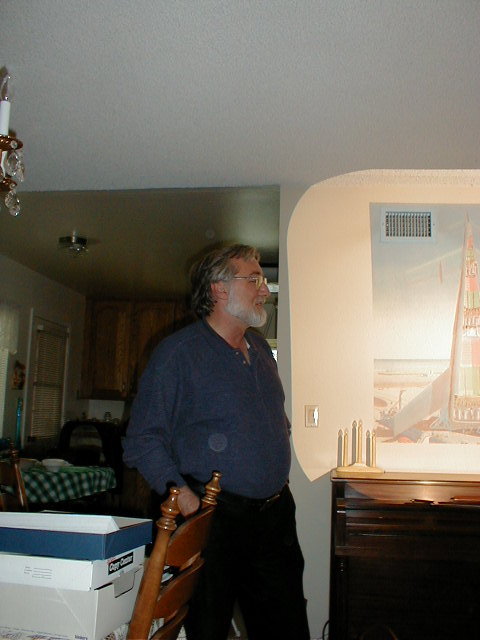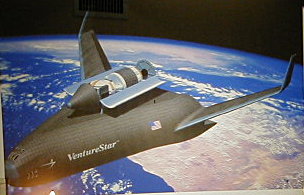






Editor: Kris Cerone
"RLVs Are HARD To Do!"
Says OASIS Speaker
Continued in the December issue
By Steve Bartlett
Professional Rocket Scientist, writer, and radio and television host Warren James briefed an OASIS audience on the history, technical issues, and tribulations of developing reusable launch vehicles (RLVs) on October 19. His talk, Reusable Launch Vehicles: Past, Present, and Future, covered the gamut of approaches developed over the past sixty years to put payloads into space and recover the launcher.
 |
| Warren James speaking at the OASIS meeting. Photograph courtesy Steve Bartlett. |
RLVs have a number of potential benefits, according to James. The most prominent of these is the ability to avoid throwing away a multi-million dollar piece of hardware on every flight. If the rocket can be recovered and reused, the overall launch costs drop dramatically. Another important benefit is eliminating the "infant mortality" of rockets that is the tendency of a system to fail on the first time it's used. "With current expendable launch vehicles, EVERY flight is that rocket's first flight!" said James. "With a reusable (launch vehicle), you work out the infant mortality problem very quickly."
Another potential benefit is that a failure of a launch vehicle system on the way to orbit won't necessarily result in the loss of the payload because the payload and vehicle can be returned to Earth and reflown. But this possible advantage comes at a significant cost in the form of larger wings, heavier "dead" weight in the rocket. "You could say that you're paying a payload recovery tax," commented the speaker.
He stated that recovery of humans from a failed launcher is very important and the Russians do it on a routine basis with "tractor rockets" on their Soyuz launch vehicles. "But no one does it with commercial satellites on expendable launch vehicles because it's just too expensive," intoned James.
He commented that one advantage that's often touted about RLVs is the ability to return hardware from orbit. What's usually not mentioned is that the things being returned usually consist of "broken hardware and dirty laundry" from the Alpha space station. This ability to return hardware from orbit comes with major impacts in the design of the launcher.
Reusability of a launcher does have a number of disadvantages in James' view. The chief among these is the weight penalty for recovering the vehicle. "You're putting a lot of dead weight into the vehicle for the last few minutes of flight," he said. In addition, RLVs tend to be larger and more complicated than expendable rockets and they have much higher development costs. He commented that the high development costs for the Space Shuttle effectively killed making it fully reusable.
Warren James went on to discuss other technical issues faced by RLV builders, particularly the question of aerodynamic stability during the return of the rocket from orbit. "When you launch a rocket, most of the weight starts out in the form of propellant that's toward the front of the vehicle. That means it's fairly easy to steer the thing. As you burn up that propellant, the center of gravity shifts further and further to the rear of the rocket and it becomes harder and harder to control. When you're coming back from orbit, most of the weight is tied up in the engines and the thing wants to fly back-end first," he said.
He described the various propellants available for RLVs and their advantages and disadvantages. The most common choice is between a combination of liquid oxygen/kerosene and liquid oxygen (LOX)/liquid hydrogen. The advantages of liquid oxygen/kerosene are its high density (which allows for smaller, lighter rockets), low cost, storability, and safety of the propellants. The major disadvantage is its lower energy per unit weight than liquid oxygen/liquid hydrogen.
 |
| Warren James slide of orbital Venture Star RLV. |
The liquid oxygen/liquid hydrogen combination has higher energy content, making it a more efficient propellant mix, but it has several disadvantages. "LOX/hydrogen is the devil's own brew," said James. "The liquid hydrogen temperature is near absolute zero. It goes through a lot of metals as if they weren't there and makes them very brittle. Plus its density is so low that you need a REALLY big tank to hold it," he remarked. "It (liquid hydrogen) has a lower density than balsa wood."
Other propellant combinations that have been suggested for RLVs, including hydrazine/nitrogen tetroxide, are highly toxic.
He discussed the sensitivity of RLVs to payload weight, where just a ten percent change in the payload weight can double the weight of the rocket. His presentation included a breakdown of the "reusability tax" for an RLV. One unique chart depicted the empty weight of an expendable launch vehicle compared to a recoverable one if both had the same payload and launched to the same orbit. His example depicted an expendable rocket with a 10,000-pound payload having an empty weight of 200,000 pounds. A reusable rocket to place the same payload in the same orbit would have an empty weight of 450,000 pounds.
You can visit Warren James on the net at Hour 25.
Continued in the December issue
Copyright © 1998-2003 Organization for the Advancement of Space Industrialization and Settlement. All Rights Reserved.